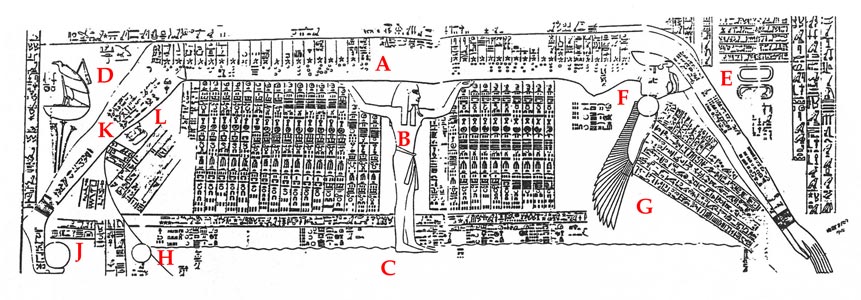|
In 1914, by an entry of thieves, Naville penetrated in a room of the Osireion, so-called room of the sarcophagus: On the ceiling, he discovered an immense representation of the sky with the body of the Nut goddess and explanatory texts (Traunecker, 2001). This scene will be called the Book of Nut, that one will recover later the ceiling of the sepulchral room of Ramsès IV. It would have been drawn under Merenptah. Another part of the ceiling is covered with a part of the Book of the Night (until the 9th hour) inscribed under Sety I (Hornung, 2007). for the Book of Nut on the ceiling of Ramsès IV, to see the site of the Theban Mapping Project, cf. page links). |
 |
|
The body of Nut (A) spreads from east to west, sustained by the god Shu (B). The Geb god (the earth C) is not represented. In the evening, the sun is swallowed by the goddess (F) and follows a given way (described in G). At the dawn, the sun (H) is below the horizon. Then the sun appears (J) and it goes up (K). The newborn sun is under the shape of a winged scarab (kheper L)). It is the visible world in which moves the sun. The Nekhbet goddess , protector of the south, is drawn at the left (D). This ceiling also consists of a description of the external world (E) : "The faraway region of the sky is dived in the obscurity, one doesn't know its limits... this country is unknown of the gods (Traunecker, 2005)." So the visible world is an illuminated bubble surrounded by a cold and sink set, that surrounds it of all parts. This drawing has been duplicated from the book of M. Clagget (1995), according to Frankfort (The cenotaph of Seti I at Abydos, London-1933). The letters are fromTraunecker (2005) and have been added by me on the drawing. |